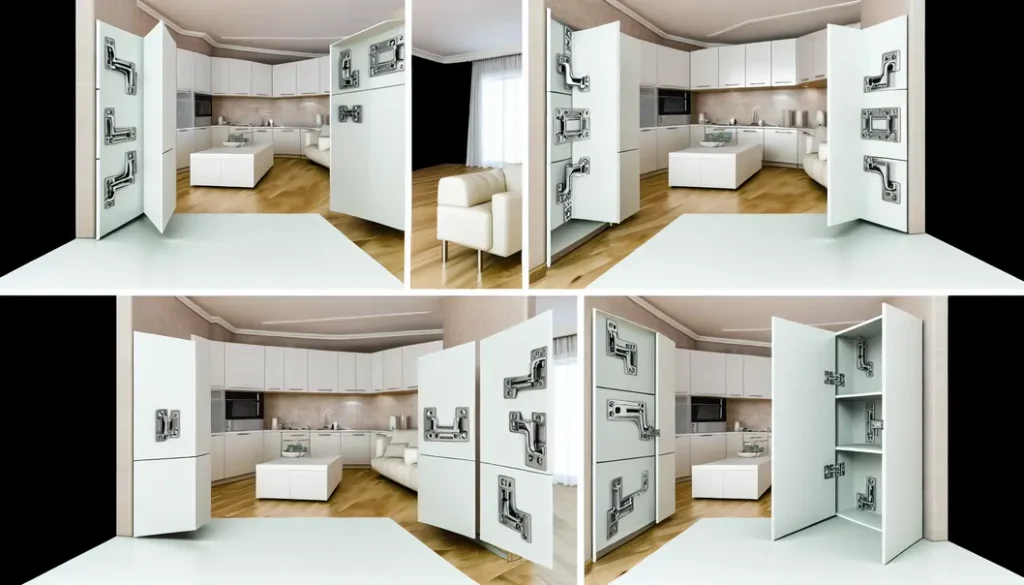European angled cabinet hinges might just be the unsung heroes of personalized home cabinetry. Despite their often unnoticed presence, these hinges provide engineered solutions to challenges that standard hardware can’t tackle. Homeowners and DIY enthusiasts aiming to customize their spaces are discovering that incorporating these specialized hinges can dramatically improve both aesthetic and functional aspects of a room. Whether dealing with tight corners, wide-opening requirements, or unique configurations, European angled hinges offer versatility that transforms simple carpentry tasks into tailored expressions of individual style. Delve into how these essential components elevate design possibilities and ensure seamless, precise application across varied kitchen, bathroom, and living room installations.
The Anatomy of a European Cabinet Hinge

European cabinet hinges, often lauded for their sleek appearance and advanced functionality, consist of several key components. At their core, these hinges comprise two main parts: the hinge cup and the arm. The hinge cup, usually fashioned from robust metal, is designed to nestle into a mortise on the back of the cabinet door, allowing for a flush, seamless aesthetic. This cup connects to the hinge arm, which, in turn, attaches to the cabinet box via a mounting plate.
The functionality of these hinges is enhanced by complex mechanisms such as adjustment screws, which allow for precise tuning. These enable three-dimensional adjustments—height, side, and depth—ensuring that cabinet doors align perfectly even when the cabinet framework is slightly irregular. This advanced adjustability is a significant upgrade over traditional hinges, which often require additional shims or extensive manual alignment.
Furthermore, many European cabinet hinges feature soft-close mechanisms, utilizing hydraulics or rubber spaces to gently close doors, adding an air of quiet sophistication to any kitchen or bathroom. This attention to detail and functionality makes European cabinet hinges a popular choice among homeowners and DIY enthusiasts. For tips on maintaining a well-organized DIY space to enhance working on such projects, consider exploring ideas on creating a healthy home environment.
Choosing the Right Hinge for Your Project

Selecting the right European hinge is crucial for achieving both functionality and aesthetic appeal in your cabinetry projects. Begin by assessing your cabinet type. Frameless and face-frame cabinets require different hinge setups; the choice impacts installation precision and final look. For frameless cabinets, concealed hinges are an ideal choice due to their seamless appearance. In contrast, face-frame cabinets demand hinges with wider mounting plates to accommodate the frame.
Next, consider overlay requirements. The overlay describes how much of the cabinet frame the door will cover. Common overlays include full, half, and inset, each suited for specific cabinet aesthetics and spatial considerations. A full overlay hinge provides a sleek finish by covering the cabinet carcass completely, while an inset hinge keeps the door flush with the cabinet frame, offering a more traditional look.
The opening angle is another critical factor. Depending on the intended function and accessibility of the cabinet, a hinge with an opening angle between 90 to 165 degrees might be needed. Adjustable hinges provide versatility by allowing you to modify the degree of opening to suit user preferences and room layout constraints.
For a healthy mind and workspace, consider how hinge choices can affect your cabinet’s ergonomics and accessibility. A thoughtful selection enhances both daily use and the harmony of your living space. For more tips on creating a serene home environment, explore this article.
Installation: Achieving Precision and Elegance

Installing European hinges requires precision and a touch of finesse to achieve the desired elegance in your cabinetry. Begin with the most crucial step: measuring accurately. A well-calibrated measuring tape is your best friend. Mark the locations for the hinge cups on the door, typically 2-3 inches from the top and bottom edges, ensuring symmetry on both sides.
Drill the cup holes carefully, using a Forstner bit of the correct diameter, usually 35mm. Keep a steady hand and ensure your drill is perpendicular to the door surface to avoid angled misalignments. Next, attach the hinge arm to the cabinet frame aligning with your pre-marked positions. Use pilot holes to prevent wood splitting, and fix the screws securely.
Testing is crucial. Before you secure all screws tightly, place the doors on the cabinet and check the alignment. Make micro-adjustments to achieve a gap of 1/16 inch between doors, allowing smooth operation and preventing jamming. Remember, achieving precision now saves future adjustments and prolongs the life of your hinges, contributing to a serene, well-functioning home. While there are many woodworking tools and techniques to explore further, consider visiting Creating a Healthy Home for a Healthy Mind for more insights on enhancing your living space.
Maintenance and Adjustment for Longevity

Proper maintenance and adjustment of European cabinet hinges ensure they remain functional over time. These hinges are designed for precision, but regular care is essential to maintain their elegance and performance. Start by periodically checking for loose screws which can compromise alignment. When tightening, ensure you do not overdo it as this can strip the screw holes and weaken the structure.
Cleaning is vital; dust and debris can build up, affecting movement. Use a soft cloth and mild cleaner to wipe them down, ensuring all pivot points are free from grime. This routine can prevent premature wear and maintain the sleek finish.
For fine-tuning, most European hinges have adjustment screws for vertical, horizontal, and depth settings. Adjust these carefully to realign cabinet doors, ensuring even gaps and smooth operation. If a door begins to sag, it’s likely time to tighten or adjust these screws. Keep the manufacturer’s instructions handy, as specific models may have unique adjustment mechanisms.
Remember, consistent maintenance not only extends lifespan but also contributes to a healthy home environment, making your living space both functional and aesthetically pleasing. This care reinforces the hinge’s technical sophistication, ensuring they remain a mark of craftsmanship in your kitchen or wardrobe.
Innovative Features and Trends

European cabinet hinges have witnessed remarkable advancements recently, infusing elegance with utility in novel ways. Among these, the soft-close mechanism stands out for its ability to prevent the slamming of doors and drawers. This feature uses integrated dampers to gently decelerate the closing motion, contributing significantly to noise reduction and enhancing the longevity of cabinetry by minimizing impact stress.
Another notable trend is the push-to-open design, which caters to a minimalist aesthetic by eliminating the need for visible handles. This system relies on precision-engineered springs that release the door open with a gentle press. It provides sleek, uninterrupted lines in kitchen and bathroom cabinetry, a preferred choice for contemporary interiors.
Moreover, the fusion of advanced materials and smart technologies is propelling hinge design towards increased adaptability and durability. High-grade metals and corrosion-resistant coatings are becoming standard, ensuring hinges remain robust and appealing over time. The integration of adjustability features allows fine-tuning of door alignment, ensuring consistent performance even as environments change.
The evolution of hinge technology is moving towards a blend of aesthetic simplicity and pragmatic functionality, addressing the needs of modern living spaces. For those interested in exploring contemporary home design, understanding these developments can provide valuable insights. To further elevate your living environment, consider adopting healthy home practices.
null
null
null
null
null
null
null
null
null
null
Final words
European angled cabinet hinges are essential in solving unconventional cabinetry challenges, providing both functionality and design flexibility. Homeowners and DIY enthusiasts can achieve unparalleled precision and customization through informed hinge selection and application. Embrace these specialized tools to transform your living spaces into tailored and efficient environments.
Complex Angles Made Simple – European Angled Hinges in Stock Corner cabinets, angled face frames, and non-standard configurations demand precision hardware. Wurth Louis stocks the complete range of European angled hinges from Blum and Hafele, with expert application guidance to solve your most challenging installations.
[Find Your Angle Solution] | [Get Expert Application Support] 95°, 110°, 125°, 155° – Every Angle Covered When standard 110° hinges won’t work, we have the specialized European angled solutions you need. From tight corner applications to wide-opening entertainment centers, our angled hinge inventory solves complex cabinet geometry challenges.
[Shop by Opening Angle] | [Consult on Complex Applications]
Learn more: https://wurthlac.com/category/795/euro-hinges-angled
About us
European Angled Cabinet Hinges Value Proposition When Standard Won’t Work – Specialty European Engineering Delivers Wurth Louis provides the specialized angled hinge solutions and application expertise that turn complex cabinet challenges into seamless installations.
Core Value Pillars Complete Angle Range Available We stock European angled hinges across the full spectrum:
95° Hinges – Tight corner applications and space constraints
110° Standard – Traditional face frame and frameless applications
125° Hinges – Bi-fold doors and wider opening requirements
155° Wide-Angle – Full-access entertainment centers and appliance panels
170° Extreme – Specialty applications requiring maximum opening
From tight corners to wide-access needs – every angle challenge covered.
📐 Application Engineering Expertise Angled hinges require precise calculation and specification. Our specialists understand:
Door swing clearance calculations for tight spaces
Weight distribution on angled mounting applications
Frame geometry impact on hinge selection
Multi-angle cabinet configurations and sequencing
Integration with European drawer systems and hardware
Result: Perfect function without trial-and-error installations.
Hard-to-Find Specialty Inventory While others require special orders and long lead times, we stock:
Blum Clip Top angled series with integrated soft-close
Hafele architectural angled concealed hinges
Salice heavy-duty angled solutions for oversized doors
Matching angled mounting plates and accessories
Installation templates for precise boring
Same-day shipping on specialty angles others can’t source.


